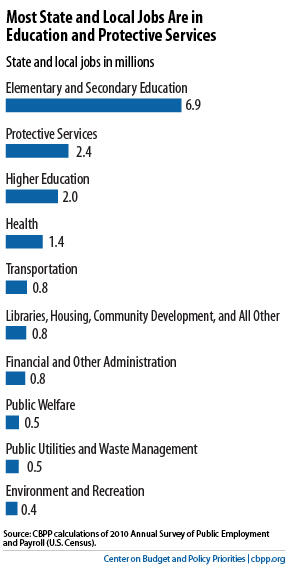BEYOND THE NUMBERS
Our updated report on state and local workers includes some basic facts that are worth keeping in mind as public employees are once again in the news.
1. Elementary and secondary education comprises — by far — the largest share of state and local government employees. Nearly 7 million teachers, aides, and support staff work in the nation’s public elementary and secondary schools. Protective services, including police officers and fire fighters, is the next largest category, with 2.4 million people. (See chart.)

2. The public workforce has grown only modestly as a share of the population over the last three decades. Outside of education, the number of public sector workers has remained about the same relative to overall population. The number of education workers grew relative to the overall population until 2008, when it began to decline.
3. Public-sector workers earn less in wages than their private-sector counterparts. The typical middle-wage worker earns about 4 percent less in the public sector than the private sector. Low-wage state and local workers, by contrast, earn a small amount more than their private-sector counterparts.
4. Counting both wages and benefits, public-sector workers on average still earn less than their private-sector counterparts, though the gap is smaller. Benefits like pensions and health insurance are larger and more secure for most public employees than for most private-sector workers, but the value of these benefits does not eliminate the gap between state and local employees and their counterparts in comparable private-sector jobs.
5. Labor costs make up a significant share of state and local spending. That’s because providing services is the primary business of states, cities, counties, school districts, and other local governments. Total compensation for state and local workers (including wages and benefits) makes up about 44 percent of state and local spending.
